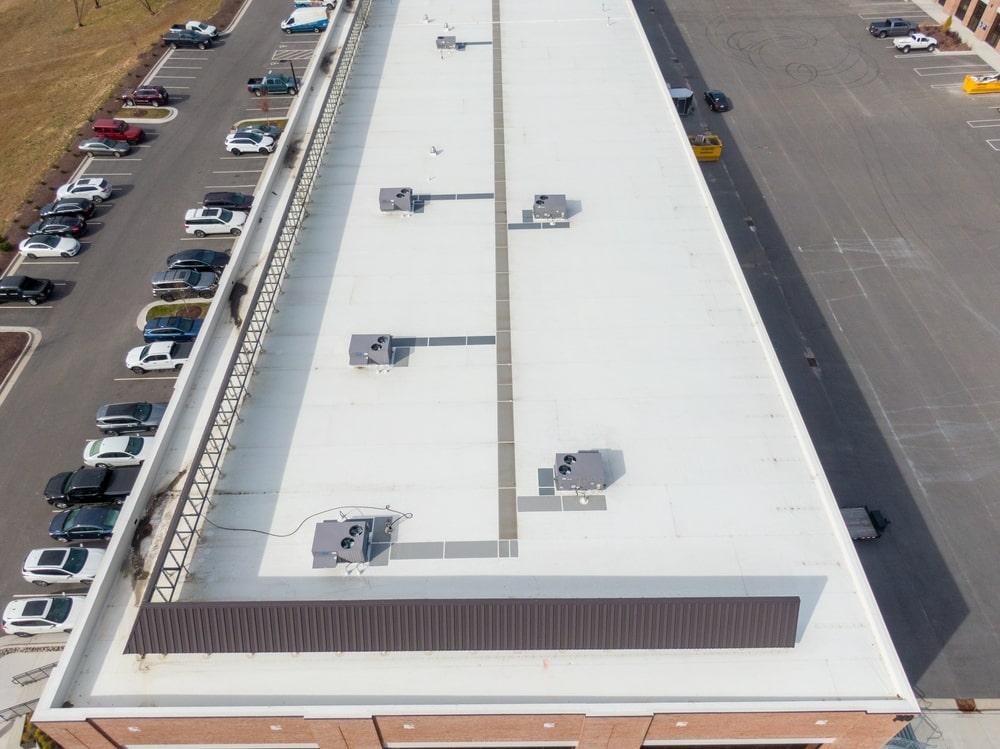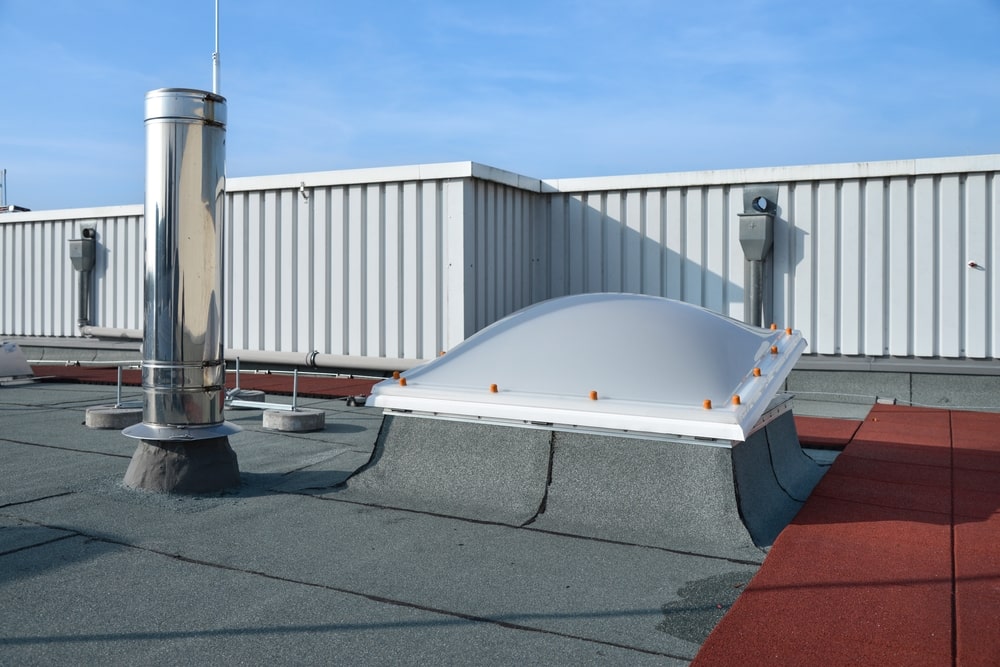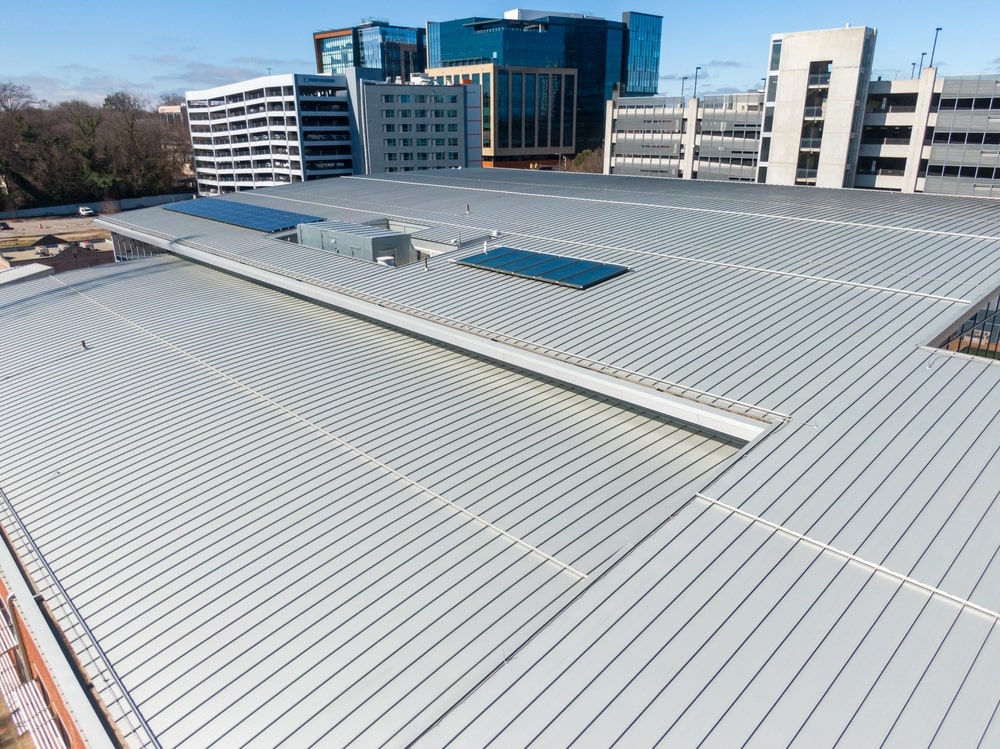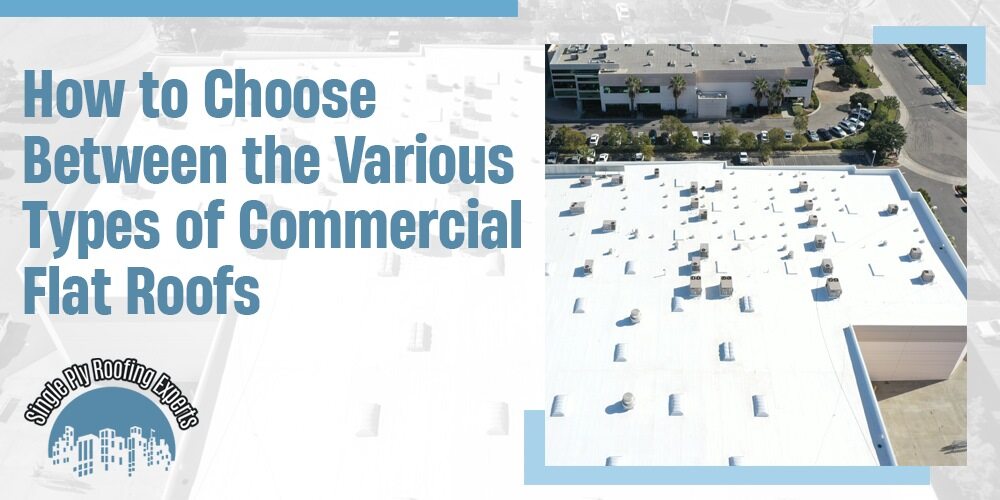When it comes to commercial flat roof construction, choosing the right system is not just a matter of durability—it’s a decision that directly impacts your energy efficiency, operational costs, and property value. Whether you’re planning new construction or replacing an old roof, the team at Single Ply Roofing Experts is here to guide you through the wide variety of options and ensure your investment pays off in both performance and longevity.
What is a Commercial Flat Roof?
A commercial flat roof is a low-slope roofing system commonly used on business, industrial, and institutional buildings. Unlike steep-sloped residential roofs, commercial flat roofs typically have a slight pitch—usually less than 10 degrees—to allow for proper drainage. These roofs are engineered to support the weight of HVAC systems, solar panels, and foot traffic, making them a practical choice for commercial applications. Built using various materials such as TPO, EPDM, PVC, or built-up roofing, commercial flat roofs offer durability, energy efficiency, and cost-effectiveness. Their design maximizes usable space and simplifies maintenance, which is why they’re a staple in commercial flat roof construction across California and beyond.
What Are the Different Types of Commercial Flat Roofs?
In the realm of commercial flat roof construction, selecting the right roofing system can significantly affect your building’s performance, longevity, and energy consumption. Whether you’re upgrading an existing structure or building from the ground up, understanding the types of commercial flat roofs in California is essential. Here’s a closer look at the most common systems and the benefits they offer:

EPDM Roofing (Rubber Membrane)
One of the most time-tested and widely used commercial flat roof materials, EPDM (Ethylene Propylene Diene Monomer) is a synthetic rubber membrane known for its exceptional performance and cost-efficiency. Commonly used in commercial flat roof construction, EPDM is a top choice for property owners seeking a straightforward, reliable solution that balances durability and value.
Advantages of EPDM Roofing:
- UV Resistance: EPDM performs well under prolonged exposure to sunlight, making it a smart option for buildings in sunny climates like California.
- Cost-Effective Installation: Thanks to its simple application process, EPDM roofs are among the most affordable flat roofing systems to install.
- Low Maintenance: Repairs are usually quick and inexpensive, often requiring only adhesive patches to seal minor leaks.
- Flexibility: The rubber membrane remains pliable over time, allowing it to adapt to building movements without cracking.
Drawbacks of EPDM Roofing:
- Puncture Vulnerability: While EPDM is tough, it can be susceptible to punctures and tears, especially in areas with heavy foot traffic or rooftop equipment.
- Heat Absorption: Unlike reflective roofing options like TPO or PVC, EPDM is typically black and can absorb more heat, which may lead to higher cooling costs unless coated with a reflective layer.
- Installation Sensitivity: Improper installation can compromise performance, so it’s essential to work with experienced roofing professionals, like those at Single Ply Roofing Experts.
Overall, EPDM remains a strong contender among the types of flat roof covering for businesses prioritizing a balance between upfront costs and long-term reliability.

TPO Roofing (Thermoplastic Polyolefin)
TPO roofing has rapidly become one of the most popular types of flat roof covering for commercial properties, and for good reason. This single-ply membrane combines the best qualities of EPDM and PVC roofing systems, offering a balance of durability, performance, and cost-efficiency that’s hard to beat. Designed with energy efficiency in mind, TPO reflects UV rays away from the building, significantly reducing interior heat gain and lowering air conditioning costs—an especially valuable feature in sun-intensive regions like California.
Advantages of TPO Roofing:
- Energy Efficiency: The bright white surface of TPO is highly reflective, helping to cool the building naturally and cut down on energy consumption.
- Chemical Resistance: TPO membranes are resistant to a wide range of chemical exposures, making them ideal for buildings with rooftop mechanical systems or industrial applications.
- Environmentally Friendly: TPO is a recyclable material, which contributes to its growing popularity among businesses aiming for greener operations.
- Flexibility and Strength: Despite being lightweight, TPO is strong enough to resist tears, punctures, and impacts, providing reliable protection for years.
Drawbacks of TPO Roofing:
- Installation Sensitivity: One of the primary concerns with TPO roofing is that it requires skilled and precise installation. Improper installation can lead to issues like seam failures or membrane shrinkage over time.
- Quality Variability: Because TPO has a relatively short history compared to other roofing systems, the quality can vary significantly depending on the manufacturer. Working with a reputable contractor like Single Ply Roofing Experts ensures that only top-grade TPO materials are used.
TPO continues to gain traction in commercial flat roof construction because it checks the boxes for affordability, efficiency, and sustainability—making it a smart investment for forward-thinking property owners.

PVC Roofing (Polyvinyl Chloride)
PVC roofing stands out as one of the most robust and adaptable options among the types of commercial flat roofs available today. Made from polyvinyl chloride, this single-ply roofing membrane is particularly well-suited for buildings that encounter harsh environmental conditions or chemical exposure—such as restaurants, factories, and manufacturing facilities. Its inherent resistance to oils, fats, and many industrial by-products makes it a top choice in commercial flat roof construction where durability and resilience are non-negotiable.
Advantages of PVC Roofing:
- Fire Resistance: PVC is inherently fire-retardant, making it ideal for facilities handling flammable substances or requiring enhanced fire safety standards.
- Lightweight Composition: Its light weight reduces the overall structural load, often eliminating the need for additional reinforcement and lowering installation costs.
- Long Lifespan: With proper maintenance, PVC roofing systems typically last between 25 to 30 years, offering excellent value over time.
- Superior Weldability: The seams are heat-welded rather than glued, creating a watertight, uniform bond that significantly reduces the risk of leaks.
- Chemical Resistance: PVC performs exceptionally well in environments exposed to oils, greases, and other harsh chemicals.
Drawbacks of PVC Roofing:
- Higher upfront cost: PVC roofing systems typically come with a steeper initial price tag, making them less attractive for budget-conscious projects.
- Cold weather performance: In extremely low temperatures, PVC can become brittle and more susceptible to cracking—though this is rarely a concern in warmer climates such as California.
- Installation sensitivity: Proper installation is critical to ensuring long-term performance, requiring skilled professionals to avoid seam issues or premature wear.

Built-Up Roofing (BUR)
PVC roofing is a premier choice in commercial flat roof construction, especially for facilities exposed to chemicals, grease, or high temperatures. Commonly used in restaurants, factories, and chemical plants, PVC membranes offer unmatched chemical resistance, making them a go-to solution among the different types of commercial flat roofs. As one of the more advanced commercial flat roof materials, PVC is known for its exceptional longevity and low maintenance needs.
Advantages of Built-Up Roofing:
- Fire-resistant: Enhances safety by reducing the risk of fire spread.
- Lightweight: Puts less structural stress on the building, which can lower construction costs.
- Long-lasting: Typically lasts 25–30 years with minimal maintenance.
- Chemically resistant: Ideal for buildings exposed to fats, oils, and industrial by-products.
- Heat-welded seams: Creates a monolithic, watertight barrier that minimizes leak risks.
Drawbacks of Built-Up Roofing:
- Higher upfront cost: More expensive to install than TPO or EPDM systems.
- Cold weather brittleness: Can become brittle in extremely cold climates—less of an issue in types of commercial flat roofs in California.
- Specialized installation required: Needs trained professionals for proper seam welding and fitting.
Despite its initial investment, PVC roofing often delivers superior value over time, making it a compelling option among the types of flat roof covering for commercial properties focused on durability and performance.

Modified Bitumen
Modified bitumen roofing is a modern evolution of traditional built-up roofing (BUR), combining the layered resilience of BUR with the advanced materials used in single-ply systems. Designed for longevity and performance, this system integrates asphalt with polymerized rubber or plastic to enhance elasticity and strength. Typically installed in multiple plies, modified bitumen can be applied using heat (torch-down), cold adhesives, or peel-and-stick methods, depending on the project requirements.
Advantages of Modified bitumen:
- Durability in Extreme Conditions: Excellent resistance to cracking and damage from freezing and thawing cycles, making it ideal for regions with temperature fluctuations.
- High Foot Traffic Tolerance: Often used in areas where maintenance workers need regular rooftop access.
- Waterproofing Reliability: The multi-layer design provides robust protection against water infiltration.
- Compatibility with Roof Accessories: Easily integrates with flashing and other roof penetrations.
Drawbacks of Modified bitumen:
- Labor-Intensive Installation: Depending on the chosen application method, installation can be time-consuming and may require specialized equipment and skilled labor.
- Safety Concerns: Torch-down applications pose fire risks and require strict adherence to safety protocols.
- Maintenance Needs: While durable, seams and flashing areas may require periodic inspections to maintain waterproofing integrity.

Metal Roofing
Metal roofing is becoming an increasingly popular choice in commercial flat roof construction, particularly for facilities that prioritize longevity, sustainability, and a modern aesthetic. Though once rare on flat-roofed commercial buildings, advancements in installation techniques and material design have made metal an attractive alternative for various property types.
Advantages of Metal Roofing:
- Extended lifespan: Can last 40–70 years with minimal maintenance.
- Durability: Resistant to fire, mold, insects, and severe weather conditions.
- Eco-friendly: Made from recyclable materials and fully recyclable at the end of its life cycle.
- Energy efficiency: Reflects sunlight, helping to reduce cooling costs during hot weather.
Drawbacks of Metal Roofing:
- High initial cost: More expensive than most other commercial flat roof materials.
- Noise issues: Can be loud during rain or hail unless properly insulated.
- Structural requirements: May need additional support to handle the weight of the metal panels.
- Complex installation: Requires experienced contractors to ensure proper fitting and sealing.
Despite the higher upfront investment, metal roofing offers exceptional long-term value, especially for businesses seeking low-maintenance, high-performance types of flat roof covering.
Choosing the Right Commercial Flat Roof Materials
Selecting the best commercial flat roof materials requires considering more than just price. The local climate, building usage, and your long-term maintenance capacity should also weigh heavily in your decision.
Key Considerations:
- Climate Resistance: Materials that perform well under California’s heat and sun.
- Building Purpose: Storage facilities, retail shops, and office buildings have different roofing needs.
- Energy Performance: Reflective surfaces like TPO and PVC can reduce cooling costs.
- Installation Costs vs. Maintenance: Consider the full lifecycle cost of your roof.
Why TPO Roofing Stands Out in California
As a leader in commercial flat roof construction, we at Single Ply Roofing Experts often recommend TPO roofing for its impressive blend of cost-efficiency, energy savings, and durability. Especially in California’s sun-drenched climate, TPO’s reflective white surface can significantly lower energy bills.
Trust Single Ply Roofing Experts for Your Roofing Needs
With decades of hands-on experience and a passion for delivering high-quality work, Single Ply Roofing Experts is your go-to partner for all commercial flat roofing materials and installations. We offer:
- Custom Solutions: Tailored recommendations based on your unique needs.
- Certified Installers: Trained professionals who follow best practices.
- Transparent Pricing: No surprises—just competitive quotes and top-tier materials.
FAQ About Types of Commercial Flat Roofs
WHAT ARE THE BEST TYPES OF COMMERCIAL FLAT ROOFS IN CALIFORNIA?
TPO and PVC roofs are particularly well-suited to California’s hot, sunny weather due to their UV resistance and reflective properties.
HOW LONG DOES COMMERCIAL FLAT ROOF CONSTRUCTION TAKE?
Most projects take between one and two weeks, depending on the roof size, existing conditions, and chosen materials.
WHAT IS THE MOST COST-EFFECTIVE FLAT ROOF COVERING?
TPO is often considered the most budget-friendly due to its combination of low material cost and high energy savings.
CAN I REUSE EXISTING FLAT ROOF MATERIALS?
It depends on their condition. Our team will conduct a thorough assessment to determine if reuse is feasible or advisable.
HOW DO I MAINTAIN MY COMMERCIAL FLAT ROOF?
Routine inspections, debris removal, and prompt patching of any visible wear or tear can greatly extend your roof’s life.
Conclusion on Types of Commercial Flat Roofs
Your roof isn’t just a structural feature—it’s a long-term investment in your building’s performance. By understanding the different types of commercial flat roofs and their respective advantages, you’re already a step ahead. Ready to move forward? Trust the professionals at Single Ply Roofing Experts to deliver a solution that matches your specific goals, whether you’re building new or replacing old. Let’s talk about how we can protect and enhance your commercial property today.

